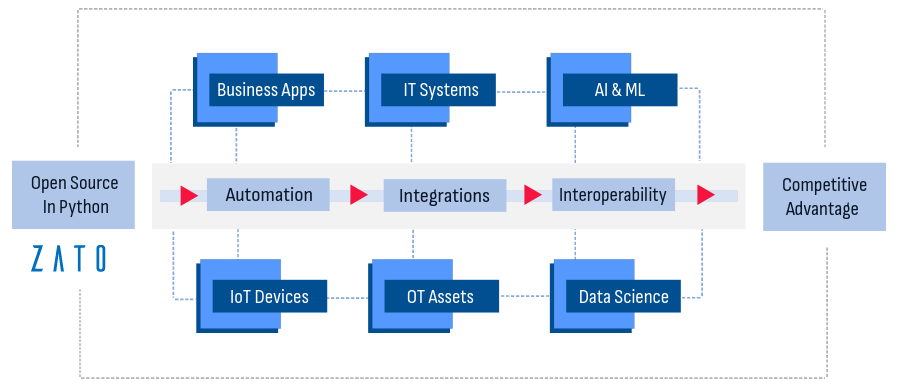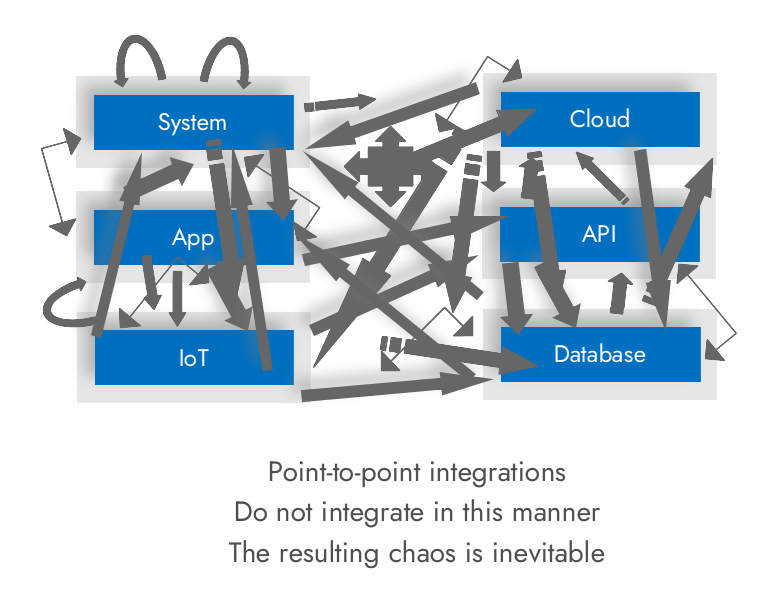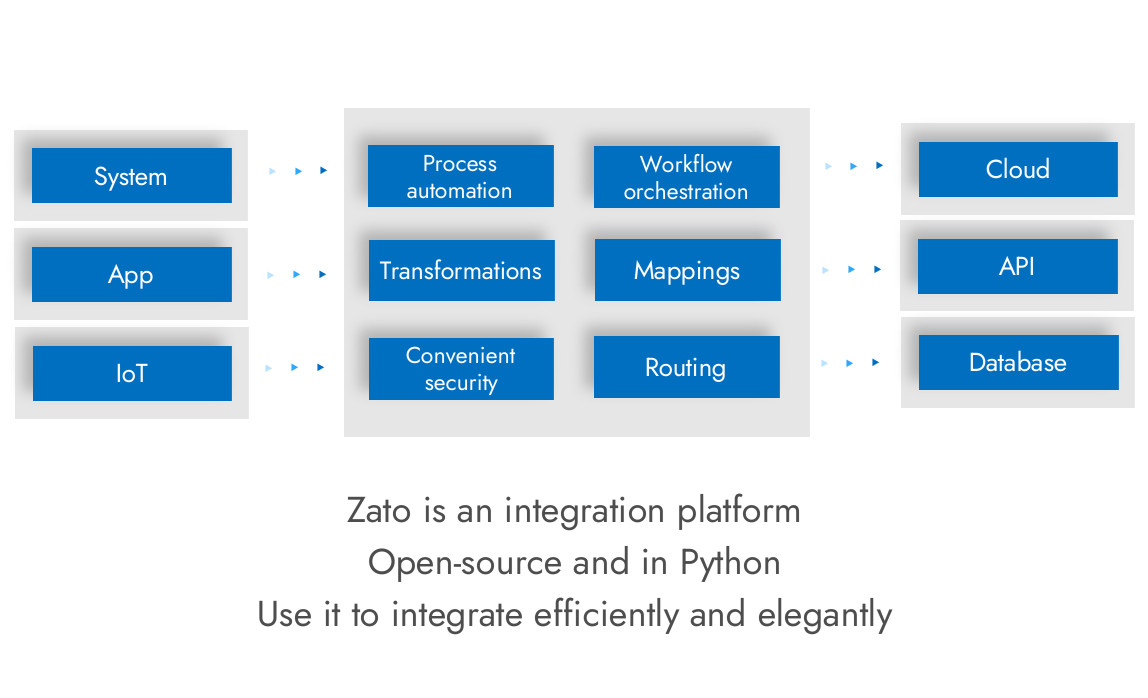Integration Platform in Python

What is an integration platform?
An integration platform seamlessly allows for unified and secure data exchange and process automation across independent applications and systems, no matter if they are on premises or in the cloud, if they are purely virtual or if they have a hardware component, and no matter if they belong to your organization or your partners and clients.
Bridging the gaps between systems, each of which will be likely written by a different vendor, while making your work enjoyable, streamlining business workflows, focusing on cohesive information flow, and helping you utilize the resources of your organization efficiently, that is the purpose of an integration platform.
How to integrate APIs and systems incorrectly?
Let's start with the opposite of what we would actually like to achieve: how to integrate incorrectly? The surest way to incorrect systems integrations is to connect them directly, one-to-one, in a point-to-point manner.
It does not matter if it is individual API endpoints or entire systems that are connected. As long as it is point-to-point, the inevitable result is this:

- You think in terms of connecting two or more specific, named systems. For instance, you connect "MyDay" and "BillingCloud" rather than considering it in higher-level terms of connecting HR and billing business functions, no matter what systems they use today.
- Your systems invoke each other directly. If a system has an API, another system will use it directly whenever it needs something, with little to no coordination, oversight and governance.
- You may have a thin layer of API endpoints, each of which connects two or more systems, but these endpoints only map data from one system to another directly, which effectively means point-to-point mappings, just in a different place of your architecture, hence point-to-point integrations again.
- The responsibility for the coordination of business process logic is vaguely defined, if at all. When messages in a process are exchanged, it is difficult to trace them and know what should happen to them depending on where in the process they are.
- Decisions about how to integrate with other systems are made by vendors of specific products being integrated, even though it is not clear if they have integration skills in addition to the skills needed to build their core products, and whether they grasp the whole picture of your business.
- Your business suffers because vendors of your systems are clearly inflexible in, or incapable of, integrating with other systems yet you can do little about it because the integration logic is deeply embedded in their products.
- You feel that building new integrations by vendors of your systems should take at most days, from inception to production, but you wait months or years for what really should be a simple job.
- You tried to automate various business processes, perhaps more than once, but you always felt you needed a more flexible tool.
- Your business people have learned to put up with the lack of automation. "It just cannot be had". This has been going on for years and you would like to change it.
Yes, it feels natural to just start invoking REST APIs. This is what they are for, after all. But if you do it point-to-point, you are setting up yourself on a course to unnecessary complexity.
What else is wrong with point-to-point? Let's discuss it, step by step:
| Key challenge | Negative impact of incorrect, point-to-point integrations |
|---|---|
| 1. API ossification |
|
| 2. Strain on people |
|
| 3. Lack of scalability and reusability |
|
The good news is that there is a correct way to do it all too. If you have already integrated many systems in a point-to-point manner, this can be straightened up.
If you have not started your integrations yet, read on as well to understand how to avoid such a messy result.
Let's check how to do it correctly now.
Correct integration architecture

With Zato as an integration platform that sits between the systems, apps AI and APIs that you integrate, you use Python to focus on the business logic exclusively and the platform takes care of scalability, availability, communication protocols, messaging, security or routing. This lets you concentrate only on what is the very core of systems integrations - making sure your API services are interesting, reusable and atomic.
An integration platform is a fundamental part of the correct architecture thanks to the platform's:
- Capacity to minimize development effort - you can achieve more with fewer people which is crucial if you are starting out with integrations and stays important as you gain experience with the job.
- Modularity, flexibility and consistency - common functionalities, such as data transformation, mappings, routing and security are expressed once and can be reused in multiple independent business processes, without influencing one another, which makes it easy to react in a flexible manner to new and ever-changing business opportunities and technical requirements.
- Reusability leading to business scalability - as business needs grow, an integration platform allows you to accommodate new applications or their migrations, and to cover previously unforeseen or unexpected business workflows and processes.
- Standardization of best practices - you are able to create a toolbox of high-quality, reliable and efficient integration components that can be applied uniformly in many scenarios, thus reducing the cognitive load on your people so that your team can achieve more while doing less, instead of being bogged down by routine tasks, which in turn fosters a culture of creativity and continuous improvement which attracts the best talent possible.
Where is an integration platform used?
Enterprise integrations
Keeping in sync systems of record and their satellites is a core example of what an integration platform does. For instance:
- CRM, ERP and billing systems
- HR, training and physical access control systems (PACS)
- Supply chain management with real-time visibility into supplier inventories
- Public records, government portals and national or local emergency systems
- Marketing and sales systems, including portals and apps for partners and vendors
- Customer support systems offering improved response times and personalized customer interactions
Cloud integrations
Cloud-based systems can offer unparalleled advantages over systems running on premises, and with their proliferation comes an increased need for an integration platform given that a typical cloud system will give you a REST API, usually with auto-generated documentation, but typically little guidance on what to do next with it, how to make it an integral part of your architecture.
A cloud-based system is one that you are going to share with many other users. Cloud vendors will rarely customize their APIs for individual clients which means that you will be required to update your integrations according to the vendor's schedule, which may not be always in line with your own ideas of when to upgrade, which in turn means that you need to be able to react to such changes in a very flexible manner that will let you retain compatibility with other components of your integrated landscape.
Hybrid integrations
A mix of on-premises and cloud systems is what a typical company uses today. Some of them are difficult to move to the cloud, with some of them it does not make any sense at all to do it, and others just keep quietly doing their job with little maintenance needed so they will continue to use your own infrastructure for many years.
A key benefit of having an integration platform is that it gives you the ability to easily switch between the two models. You can start in either way, run your IT infrastructure in a plug and play manner, and keep using a balanced blend of traditional and modern approaches, depending on what is most practical and desirable in a given case.
IoT and hardware integrations
Increased operational efficiency, the gathering of data to gain useful insights, as well as smart decision-making, all require extensive integrations and automation.
Sensors, energy monitoring systems and inventory applications collect real-time data but the information needs to be distributed in a sensible manner - and typically, a single source of data will send messages to multiple destinations.
An interesting challenge in IoT and hardware integrations is that the sources that send raw data have physically little room for advanced logic. They are often small devices, with little computing power available and it is an integration platform that provides this logic of how to smartly route, transform and distribute the messages to the apps that need them.
Open-source integration platform
The ease of getting started with an open-source platform is a clear benefit. There are no trials and no lengthy discussions with a vendor. Just go to downloads, choose your preferred system and you can start using the platform immediately.
A subtle advantage of open source becomes evident only after you are deeply committed to a product. The reality of integrations is that systems can interact in many non-obvious ways and the ability to truly understand what your platform is doing, that is, being able to check its source code, to confirm that it does what you think it should be doing, instead of waiting for days or weeks for a reply from a vendor who does not really know you, this unlocks a spectrum of previously untapped possibilities.
Premium, enterprise support is naturally available, combining the best of both worlds: open source and commercial.
Python API integrations

Python is the perfect choice for the job of complex integrations because it hits the sweet spot under several key headings:
- It is a very high level language, with a syntax close to how grammar of various spoken languages works, which makes it easy to translate business requirements into implementation.
- It is a solid, mainstream, fully-featured, real programming language rather than a domain-specific one, which means that it offers you a great degree of flexibility and choice in expressing your needs.
- It is difficult to find universities without Python courses. Most people entering the workforce already know Python - it has become a new career language. In fact, it is becoming increasingly difficult to find new talent who would not prefer to use Python.
- Yet, one does not need to be a developer or a full-time programmer to use Python. Most people who use Python are not programmers at all. They are specialists in other fields who also need to use a programming language to automate or integrate their work in a meaningful way.
- Many Python users come from backgrounds in network and cybersecurity engineering - fields that naturally require a lot of automation using a real language that is convenient and easy to get started with.
- Many Python users are scientists with a background in AI, ML and data science, applying their domain-specific knowledge in processes that, by their very nature, require them to collect and integrate data from independent sources, which again leads to automation and integrations.
- Many Python users have a strong web programming background. This means that it takes little effort to take a step further, towards automation and integrations. In turn, this means that it is easy to find good people for API projects.
- Many Python users know multiple programming languages - this is very useful in the context of integration projects where one is typically faced with dozens of technologies, vendors or integration methods and techniques.
- Lower maintenance costs - thanks to the language's unique design, Python programmers tend to produce code that is easy to read and understand. From the perspective of multi-year maintenance, reading and analyzing code, rather than writing it, is what most people do most of the time, making sense to use a language that makes it easy to carry out the most common tasks.
- In short, Python can be construed as executable pseudo-code with many of its users already having experience with modern automation and integrations so Python, both from a technical and strategic perspective, is a natural choice for both simple and complex, sophisticated automation, integration and interoperability solutions. This is why Zato is designed specifically with Python people in mind.
Keep in mind that change is the only unchanging factor. The only assumption that we can make about our work is that everything will perpetually undergo change.
Systems will be rewritten, people will leave, vendors will come and go, and not all of them will be always friendly to your organization, companies will merge and break apart, new business requirements will keep appearing in reaction to external events, and everything will be in motion.
No longer-term pause will appear on the horizon. Expect change, be prepared to adapt flexibly, attract great talent, do not let your systems and integrations ossify, and you will not be surprised when change comes, as it shall, inevitably.




 — John Adams
— John Adams